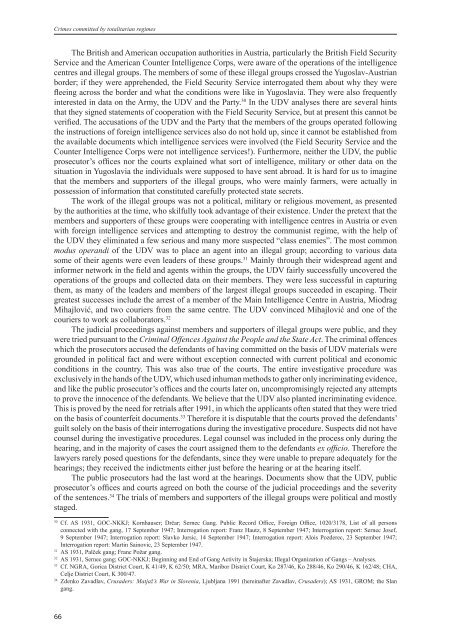crimes committed by totalitarian regimes - Ministrstvo za pravosodje
crimes committed by totalitarian regimes - Ministrstvo za pravosodje
crimes committed by totalitarian regimes - Ministrstvo za pravosodje
You also want an ePaper? Increase the reach of your titles
YUMPU automatically turns print PDFs into web optimized ePapers that Google loves.
Crimes <strong>committed</strong> <strong>by</strong> <strong>totalitarian</strong> <strong>regimes</strong><br />
The British and American occupation authorities in Austria, particularly the British Field Security<br />
Service and the American Counter Intelligence Corps, were aware of the operations of the intelligence<br />
centres and illegal groups. The members of some of these illegal groups crossed the Yugoslav-Austrian<br />
border; if they were apprehended, the Field Security Service interrogated them about why they were<br />
fleeing across the border and what the conditions were like in Yugoslavia. They were also frequently<br />
interested in data on the Army, the UDV and the Party. 30 In the UDV analyses there are several hints<br />
that they signed statements of cooperation with the Field Security Service, but at present this cannot be<br />
verified. The accusations of the UDV and the Party that the members of the groups operated following<br />
the instructions of foreign intelligence services also do not hold up, since it cannot be established from<br />
the available documents which intelligence services were involved (the Field Security Service and the<br />
Counter Intelligence Corps were not intelligence services!). Furthermore, neither the UDV, the public<br />
prosecutor’s offices nor the courts explained what sort of intelligence, military or other data on the<br />
situation in Yugoslavia the individuals were supposed to have sent abroad. It is hard for us to imagine<br />
that the members and supporters of the illegal groups, who were mainly farmers, were actually in<br />
possession of information that constituted carefully protected state secrets.<br />
The work of the illegal groups was not a political, military or religious movement, as presented<br />
<strong>by</strong> the authorities at the time, who skilfully took advantage of their existence. Under the pretext that the<br />
members and supporters of these groups were cooperating with intelligence centres in Austria or even<br />
with foreign intelligence services and attempting to destroy the communist regime, with the help of<br />
the UDV they eliminated a few serious and many more suspected “class enemies”. The most common<br />
modus operandi of the UDV was to place an agent into an illegal group; according to various data<br />
some of their agents were even leaders of these groups. 31 Mainly through their widespread agent and<br />
informer network in the field and agents within the groups, the UDV fairly successfully uncovered the<br />
operations of the groups and collected data on their members. They were less successful in capturing<br />
them, as many of the leaders and members of the largest illegal groups succeeded in escaping. Their<br />
greatest successes include the arrest of a member of the Main Intelligence Centre in Austria, Miodrag<br />
Mihajlović, and two couriers from the same centre. The UDV convinced Mihajlović and one of the<br />
couriers to work as collaborators. 32<br />
The judicial proceedings against members and supporters of illegal groups were public, and they<br />
were tried pursuant to the Criminal Offences Against the People and the State Act. The criminal offences<br />
which the prosecutors accused the defendants of having <strong>committed</strong> on the basis of UDV materials were<br />
grounded in political fact and were without exception connected with current political and economic<br />
conditions in the country. This was also true of the courts. The entire investigative procedure was<br />
exclusively in the hands of the UDV, which used inhuman methods to gather only incriminating evidence,<br />
and like the public prosecutor’s offices and the courts later on, uncompromisingly rejected any attempts<br />
to prove the innocence of the defendants. We believe that the UDV also planted incriminating evidence.<br />
This is proved <strong>by</strong> the need for retrials after 1991, in which the applicants often stated that they were tried<br />
on the basis of counterfeit documents. 33 Therefore it is disputable that the courts proved the defendants’<br />
guilt solely on the basis of their interrogations during the investigative procedure. Suspects did not have<br />
counsel during the investigative procedures. Legal counsel was included in the process only during the<br />
hearing, and in the majority of cases the court assigned them to the defendants ex officio. Therefore the<br />
lawyers rarely posed questions for the defendants, since they were unable to prepare adequately for the<br />
hearings; they received the indictments either just before the hearing or at the hearing itself.<br />
The public prosecutors had the last word at the hearings. Documents show that the UDV, public<br />
prosecutor’s offices and courts agreed on both the course of the judicial proceedings and the severity<br />
of the sentences. 34 The trials of members and supporters of the illegal groups were political and mostly<br />
staged.<br />
30<br />
Cf. AS 1931, GOC-NKKJ; Kornhauser; Drčar; Sernec Gang. Public Record Office, Foreign Office, 1020/3178, List of all persons<br />
connected with the gang, 17 September 1947; Interrogation report: Franz Hautz, 8 September 1947; Interrogation report: Sernec Josef,<br />
9 September 1947; Interrogation report: Slavko Jursic, 14 September 1947; Interrogation report: Alois Pozderec, 23 September 1947;<br />
Interrogation report: Martin Sainovic, 23 September 1947.<br />
31<br />
AS 1931, Palček gang; Franc Požar gang.<br />
32<br />
AS 1931, Sernec gang; GOC-NKKJ; Beginning and End of Gang Activity in Štajerska; Illegal Organi<strong>za</strong>tion of Gangs – Analyses.<br />
33<br />
Cf. NGRA, Gorica District Court, K 41/49, K 62/50; MRA, Maribor District Court, Ko 287/46, Ko 288/46, Ko 290/46, K 162/48; CHA,<br />
Celje District Court, K 300/47.<br />
34<br />
Zdenko Zavadlav, Crusaders: Matjaž’s War in Slovenia, Ljubljana 1991 (hereinafter Zavadlav, Crusaders); AS 1931, GROM; the Slan<br />
gang.<br />
66




